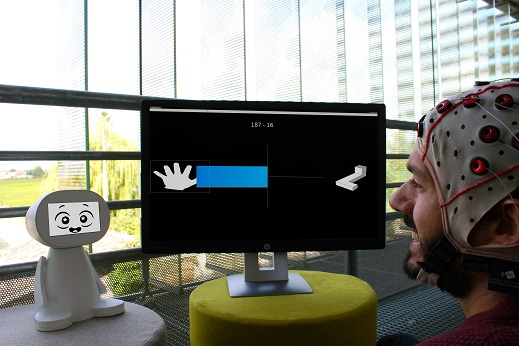Section: New Results
Improving Mental Imagery BCI user-training & feedback
Spatial Ability Training Protocol
Participants : Suzy Teillet, Camille Jeunet, Fabien Lotte
The results of one of our previous studies suggested that users' MI-BCI performance correlates with their spatial abilities [34], which is consistent with the literature. This result was replicated in a second study in a pure motor-imagery based BCI [16]. We thus decided to explore the potential causal relationship between both: would an improvement of spatial abilities lead to better MI-BCI performances? To try to answer this question, we designed and implemented a spatial ability (SA) training procedure (see Figure 14). Then, we performed two user studies to validate the SA training procedure: results suggest that it efficiently improves participants' SA [29]. Consequently, we included this SA training procedure in an MI-BCI protocol. Results (N=24) showed no difference in classification accuracy between participants performing 6 MI-BCI sessions and those performing 3 SA and 3 MI-BCI sessions. Nonetheless, SA training intensity impacted users' progression, and neurophysiological analyses provided us with valuable insights into brain pattern evolution throughout the training process.
|
PEANUT: Personalised Emotional Agent for Neurotechnology User-Training
Participants : Léa Pillette, Camille Jeunet, Boris Mansencal, Fabien Lotte
|
Mental-Imagery based Brain-Computer Interfaces (MI-BCI) are neurotechnologies enabling users to control applications using their brain activity alone. These neurotechnologies are very promising. However, existing training protocols do not enable every user to acquire the skills needed to use them. Indeed, those protocols are not consonant with psychological field recommendations. In particular, the current protocols do not provide social presence and emotional support to the user. Therefore, we designed and tested PEANUT, the first Learning Companion dedicated to the improvement of MI-BCI user-training. PEANUT has been designed throughout a combination of recommendations from the literature, the analysis of data from previous experiments and user-studies. He provides emotional support using spoken sentences, such as "`C'est avec la pratique que l'on progresse"', and facial expressions. Experiments were conducted in order to assess his influence on user's performance and experience. The first results indicate that PEANUT improves the user experience. Indeed, people who trained with PEANUT found it was easier to learn and memorize how to use the MI-BCI system and rated themselves more efficient and effective than participants who had no learning companion. These results indicate that using PEANUT does benefit MI-BCI user training. Future research will keep focusing on how to provide adapted cognitive and emotional feedback to MI-BCI users thanks to the use of learning companions.




